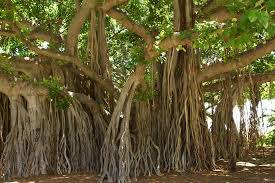National Tree of India
The banyan tree holds the esteemed title of “National Tree of India” as it symbolizes the sacrifices made by hundreds of rebels during India’s struggle for independence from the British. The British hanged these rebels from the branches of banyan trees, turning them into silent witnesses of a turbulent era.
Expansive Canopy Coverage:
The Banyan Tree (Ficus benghalensis) is one of more than 750 species of fig trees, considered the world’s largest tree in terms of the area they cover. The largest one alive today, “Thimm Amma Merriman,” located in the Indian State of Andhra Pradesh, covers 1.9 hectares (4.7 acres) and can shelter 20,000 people.
Historical Records and Evidences:
The first Europeans to come across banyan trees were Alexander the Great and his army during their arrival in India in 326 BCE. Their observations were later shared in Greece and reached Theophrastus, considered the father of modern botany. These early accounts eventually inspired the 17th-century English poet John Milton, who wrote in “Paradise Lost” that Adam and Eve used banyan leaves to make their first garments

Strangler Fig:
Beginning life as an epiphyte, the banyan germinates on other trees. As the seeds of a Banyan grow on its host, it drops its roots to the ground, and they slowly grow around the other tree. After years of growth, the host will be ‘strangled’ and die, hence also known as “Strangler Fig”.
Unique Pollination by Fig Wasps:
Pollination in most of the figs, including banyan, is unique as the only agent here is the fig wasps to facilitate the pollination. A tiny fig wasp (EU Pristina mason) enters the banyan fig through a small opening called the ostiole to lay eggs inside, in the process, pollinates the flowers inside, which often results in the wasp dying inside the fig. The banyan and fig wasp are both vital for each other’s existence.
Ecological Keystone Species:
It is a major keystone species in tropical ecosystems. It produces abundant figs year-round, which are a vital food source for a wide range of birds, bats, and primates. In addition to its fruit, the banyan provides shelter and nesting sites, offering essential habitat and food for diverse wildlife, including birds, mammals, insects, and butterflies. Its extensive canopy and aerial roots create a microhabitat that supports rich biodiversity, making it central to the health and stability of the ecosystem.
Aerial Roots Forming New Trunks:
It develops distinctive aerial roots, known as adventitious or prop roots, which descend from its branches and anchor into the soil. These roots provide structural support, helping to bear the weight of the wide-spreading branches. Over time, they form additional trunks, allowing a single tree to expand and resemble a grove.
Sacred in Multiple Religions:
The Banyan tree is revered across various faiths for its spiritual symbolism. In Hinduism, it represents endurance, wisdom, and divine connection, often serving as a sacred site and symbolizing great outcomes from small beginnings. In Jainism, it is linked to meditation and spiritual growth, while in Vaishnavism, it is a place of worship. In Buddhism, the tree signifies interconnectedness, support, and the cycle of life, featuring in teachings on reflection, gratitude, and existence. Its vast canopy and roots symbolize strength, refuge, and the unity of life.

Medical Application:
Banyan holds immense medicinal importance, as every part of the tree is used in Ayurveda and for various medicinal purposes. Traditionally, banyan leaves are used to treat diarrhoea, dysentery, and to strengthen uterine muscles during pregnancy. The bark helps manage diabetes, while the root paste is applied to firm the skin. The roots also serve as natural toothbrushes to support oral health. Its milky latex is used to treat warts and reduce inflammation.

Banyan Tree as Climate Stabilizer:
Banyan trees play a crucial role in mitigating climate change and improving air quality. Their expansive canopies and dense foliage absorb significant amounts of carbon dioxide, helping to reduce greenhouse gases in the atmosphere. These majestic trees also contribute to regulating local temperatures by providing shade and cooling the surrounding air through evapotranspiration. Their extensive root systems prevent soil erosion and improve groundwater recharge, making them essential in maintaining soil stability and sustaining water resources in the ecosystem.
Conclusion
The banyan tree is more than just a tree; it also represents life, perseverance, and community. Due to its ecological benefits, historical significance, cultural relevance, and scenic beauty, it is an essential component of our environment. We can guarantee that future generations will continue to appreciate the banyan tree's beauty and benefits by participating in initiatives like the Billion Trees campaign. Let's Givemetree.org and we plant, nurture, and celebrate together🌳.

